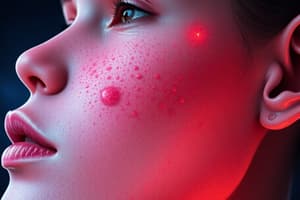Podcast
Questions and Answers
Keratinocyte dysplasia is a term related to skin cell abnormalities.
Keratinocyte dysplasia is a term related to skin cell abnormalities.
True (A)
Field cancerization is a concept that suggests only localized treatment is needed for skin lesions.
Field cancerization is a concept that suggests only localized treatment is needed for skin lesions.
False (B)
The publication's title and abstract include topics on prevention and treatment.
The publication's title and abstract include topics on prevention and treatment.
True (A)
AK stands for advanced keratitis in the context of skin lesions.
AK stands for advanced keratitis in the context of skin lesions.
Diagnosis is not a focus in the context of skin-related publications.
Diagnosis is not a focus in the context of skin-related publications.
'Keratosis senilis' is synonymous with 'senile keratoma'.
'Keratosis senilis' is synonymous with 'senile keratoma'.
SCC typically refers to a benign condition related to keratosis.
SCC typically refers to a benign condition related to keratosis.
AK is considered a precancerous condition.
AK is considered a precancerous condition.
The recommendation for treating AK is currently confirmed.
The recommendation for treating AK is currently confirmed.
'Keratoma senile' is another term for 'keratosis senilis'.
'Keratoma senile' is another term for 'keratosis senilis'.
Dermatoscopy assists in the differential diagnosis of actinic keratosis and other skin neoplasms.
Dermatoscopy assists in the differential diagnosis of actinic keratosis and other skin neoplasms.
The level of evidence for the effectiveness of dermatoscopy is rated as 2.
The level of evidence for the effectiveness of dermatoscopy is rated as 2.
There is a 100% strength of consensus regarding the use of dermatoscopy for diagnosis.
There is a 100% strength of consensus regarding the use of dermatoscopy for diagnosis.
Dermatoscopy is effective only for diagnosing melanoma.
Dermatoscopy is effective only for diagnosing melanoma.
The consensus on dermatoscopy's effectiveness is low at 50%.
The consensus on dermatoscopy's effectiveness is low at 50%.
Flashcards
Keratinocyte Dysplasia
Keratinocyte Dysplasia
Abnormal growth of keratinocytes, the cells that make up the skin.
keratosis senilis
keratosis senilis
A skin condition associated with aging.
senile keratoma
senile keratoma
A benign skin growth in elderly individuals.
Field Cancerization
Field Cancerization
Signup and view all the flashcards
keratoma senile
keratoma senile
Signup and view all the flashcards
AK
AK
Signup and view all the flashcards
in situ SCC type AK
in situ SCC type AK
Signup and view all the flashcards
Skin Cancer Prevention
Skin Cancer Prevention
Signup and view all the flashcards
Skin Cancer Diagnosis
Skin Cancer Diagnosis
Signup and view all the flashcards
AK
AK
Signup and view all the flashcards
Skin Cancer Treatment
Skin Cancer Treatment
Signup and view all the flashcards
Dermatoscopy
Dermatoscopy
Signup and view all the flashcards
Differential diagnosis
Differential diagnosis
Signup and view all the flashcards
Actinic keratosis
Actinic keratosis
Signup and view all the flashcards
Skin neoplasms
Skin neoplasms
Signup and view all the flashcards
Level of evidence 1
Level of evidence 1
Signup and view all the flashcards
Strength of consensus 100%
Strength of consensus 100%
Signup and view all the flashcards
Study Notes
European Consensus-Based Guideline for Actinic Keratoses
- This guideline provides interdisciplinary recommendations for the diagnosis, treatment, and prevention of actinic keratoses (AKs), epithelial UV-induced dysplasia, and field cancerization.
- It's based on expert consensus and current literature.
- AKs are potential precursors to cutaneous squamous cell carcinoma (cSCC)
- AKs have histopathological and immunohistochemical features of cSCC in an early stage.
- Progression to cSCC is not predictable, and treatment is usually recommended.
- Diagnosis is typically made through clinical examination. Dermatoscopy, confocal microscopy, optical coherence tomography, or line-field confocal optical coherence tomography can aid in diagnosis.
- Biopsy is indicated for clinically or dermatoscopically suspicious and/or treatment-refractory lesions.
Introduction
- Guidelines address epithelial dysplasia (including AKs).
- Increased incidence of keratinocyte cancers is notable.
- Different classification schemes exist (e.g. for epithelial dysplasia and AKs) to guide treatments.
- New insights into treatments are crucial for preventing invasive cutaneous squamous cell carcinoma.
Definition, Epidemiology, Etiology, and Diagnosis
- Actinic keratosis (AK) is a common cutaneous keratinocyte dysplasia.
- It involves abnormal proliferation of atypical epidermal keratinocytes.
- AK is a carcinoma precursor.
- The term "in situ SCC" can be used to define AKs.
- Current literature defines field cancerization as the area around a visible AK with genetic changes similar to AKs' (e.g. telangiectasia, atrophy, pigmentation abnormalities, or a sandpaper-like texture). A visible AK lesion isn't always required for field cancerization.
Pathophysiology
- AKs arise from chronic sun exposure.
- Locations are typically chronically sun-damaged areas.
- UVB radiation may induce mutations.
- UV radiation and HPV infection may influence AK development.
- Immunosuppression is a major risk factor.
Epidemiology
- Prevalence varies widely, depending on study location characteristics, UV radiation levels, and study settings.
- Higher prevalence in older individuals.
- Usually, higher rates in males.
- Risk factors include age, fair skin type, light hair/eye color, freckles, chronic sun exposure, sunburn history.
- Lower risk in sun-protective measures users and individuals with atopic history.
Clinical and Non-Invasive Diagnosis
- AKs manifest as rough, scaly patches, papules, or plaques in chronically sun-exposed areas.
- Colour ranges from red, light, or dark brown.
- Dermatoscopy (evaluation with a dermatoscope) is valuable for improving AK diagnosis.
- RCM (reflectance confocal microscopy) and OCT (optical coherence tomography) aid in AK and SCC differentiation.
Histopathological Confirmation
- Histological confirmation is crucial for equivocal lesions or for differentiating AKs from BCC or cSCC (cutaneous squamous cell carcinoma).
- In order to evaluate the possibility of iSCC (invasive squamous cell carcinoma) or other skin cancers, a biopsy is recommended in case of infiltration, induration, pain, ulceration, increase in thickness, and rapid growing.
- Classifications exist to predict the likelihood of progression to cSCC.
Treatment of Actinic Keratoses
- Goal is to prevent progression to cSCC.
- Risk of progression is significantly higher in immunocompromised patients.
- Treatment strategies can be lesion-directed (individual AKs) or field-directed (multiple AKs).
- Field-directed treatments are often more convenient for widespread, subclinical AKs in sun-damaged fields.
- Lesion-directed treatments utilize destructive methods (surgery, cryotherapy, laser therapy).
- Topical treatments (5-FU, imiquimod, PDT) are employed for lesion-directed and/or field-directed therapy.
Combination Treatments
- Combining interventions may have synergistic effects, leading to better clearance rates.
- Field-directed treatment can be complemented with lesion-directed treatments.
Treatment in Immunocompromised Patients
- Chronic immunosuppression significantly increases cSCC risk.
- Management strategies include reducing immunosuppressive regimens (azathioprine elimination, mTOR inhibitor regimens), photoprotection, and chemoprevention (retinoids).
Prevention and Follow-up
- Sun protection measures (sunscreen, clothing, avoiding midday sun exposure) are essential for preventing AK development.
- Regular follow-up visits are crucial for skin evaluation, especially in high-risk patients or those with a history of cSCC, to detect recurrence or new lesions. Follow-up frequency depends on existing AK numbers and evolution, and immune status and medication.
Studying That Suits You
Use AI to generate personalized quizzes and flashcards to suit your learning preferences.




